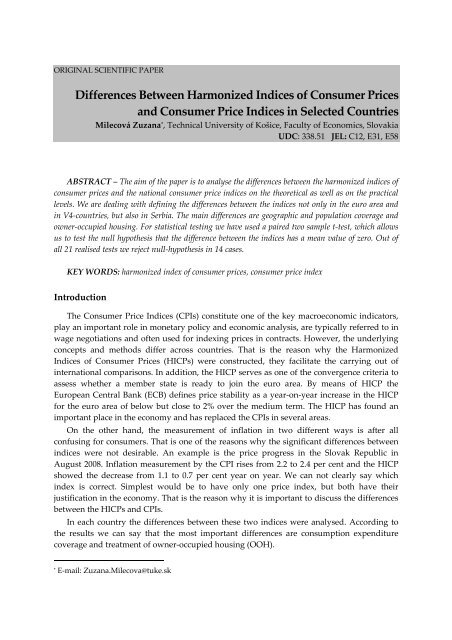Twice a Year Scientific Journal
Twice a Year Scientific Journal
Twice a Year Scientific Journal
Create successful ePaper yourself
Turn your PDF publications into a flip-book with our unique Google optimized e-Paper software.
ORIGINAL SCIENTIFIC PAPER<br />
Differences Between Harmonized Indices of Consumer Prices<br />
and Consumer Price Indices in Selected Countries<br />
Milecová Zuzana * , Technical University of Košice, Faculty of Economics, Slovakia<br />
UDC: 338.51 JEL: C12, E31, E58<br />
ABSTRACT – The aim of the paper is to analyse the differences between the harmonized indices of<br />
consumer prices and the national consumer price indices on the theoretical as well as on the practical<br />
levels. We are dealing with defining the differences between the indices not only in the euro area and<br />
in V4-countries, but also in Serbia. The main differences are geographic and population coverage and<br />
owner-occupied housing. For statistical testing we have used a paired two sample t-test, which allows<br />
us to test the null hypothesis that the difference between the indices has a mean value of zero. Out of<br />
all 21 realised tests we reject null-hypothesis in 14 cases.<br />
KEY WORDS: harmonized index of consumer prices, consumer price index<br />
Introduction<br />
The Consumer Price Indices (CPIs) constitute one of the key macroeconomic indicators,<br />
play an important role in monetary policy and economic analysis, are typically referred to in<br />
wage negotiations and often used for indexing prices in contracts. However, the underlying<br />
concepts and methods differ across countries. That is the reason why the Harmonized<br />
Indices of Consumer Prices (HICPs) were constructed, they facilitate the carrying out of<br />
international comparisons. In addition, the HICP serves as one of the convergence criteria to<br />
assess whether a member state is ready to join the euro area. By means of HICP the<br />
European Central Bank (ECB) defines price stability as a year-on-year increase in the HICP<br />
for the euro area of below but close to 2% over the medium term. The HICP has found an<br />
important place in the economy and has replaced the CPIs in several areas.<br />
On the other hand, the measurement of inflation in two different ways is after all<br />
confusing for consumers. That is one of the reasons why the significant differences between<br />
indices were not desirable. An example is the price progress in the Slovak Republic in<br />
August 2008. Inflation measurement by the CPI rises from 2.2 to 2.4 per cent and the HICP<br />
showed the decrease from 1.1 to 0.7 per cent year on year. We can not clearly say which<br />
index is correct. Simplest would be to have only one price index, but both have their<br />
justification in the economy. That is the reason why it is important to discuss the differences<br />
between the HICPs and CPIs.<br />
In each country the differences between these two indices were analysed. According to<br />
the results we can say that the most important differences are consumption expenditure<br />
coverage and treatment of owner-occupied housing (OOH).<br />
*<br />
E-mail: Zuzana.Milecova@tuke.sk
















